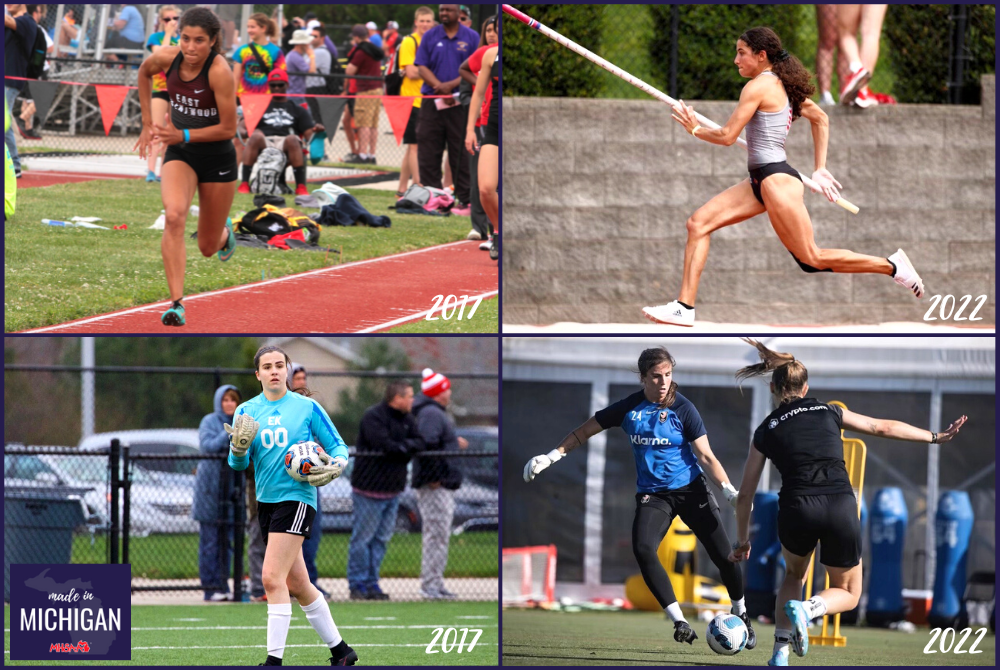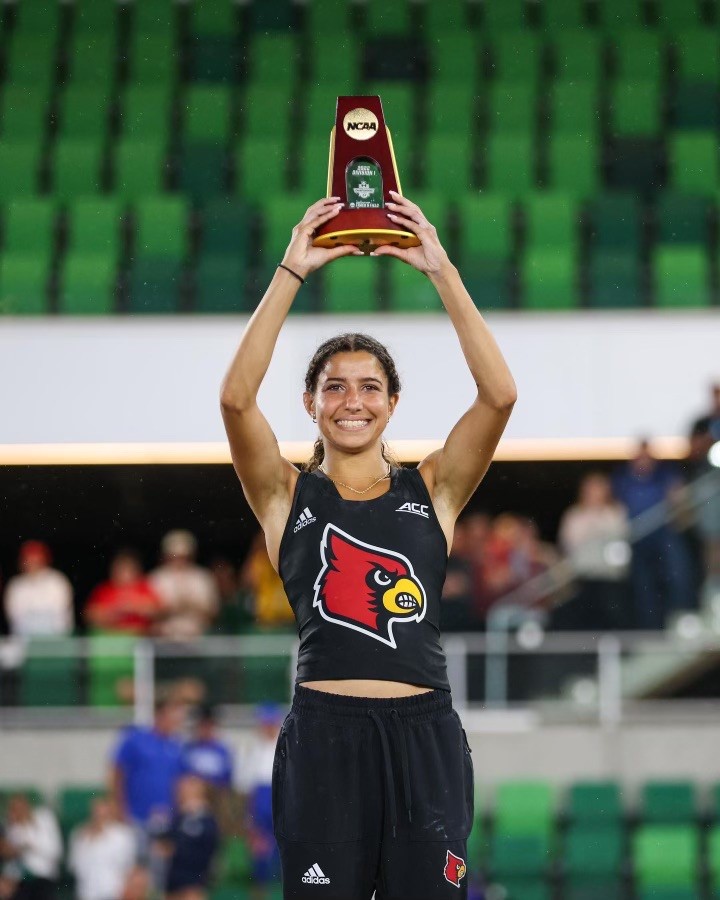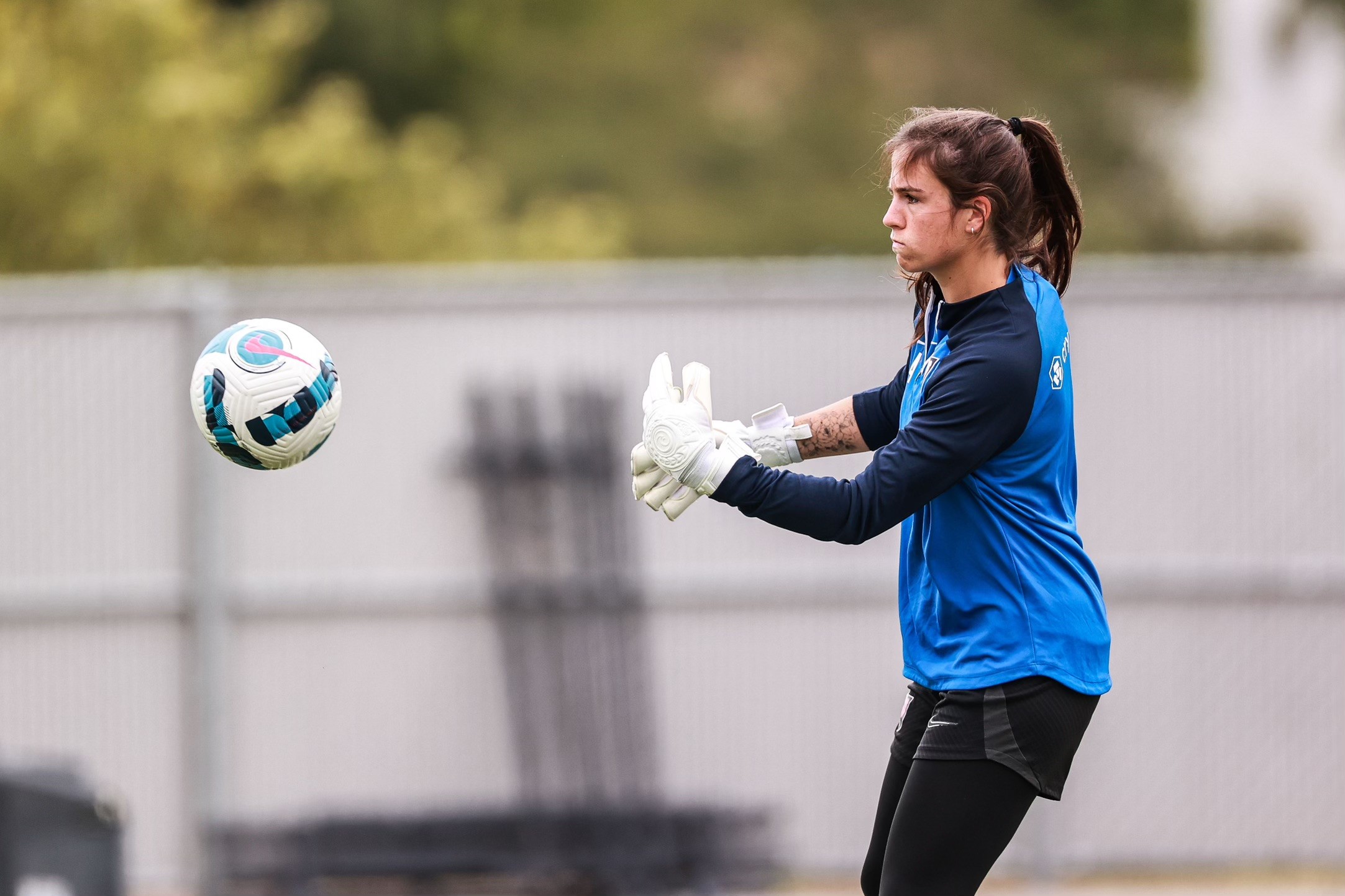
East Kentwood Friends Continuing to Excel as NCAA Champ, Pro Soccer Keeper
By
Steve Vedder
Special for MHSAA.com
August 8, 2022
Maia Perez and Gabriela Leon saw it coming.
In fact, the two 2017 East Kentwood all-staters each predicted remarkable post-high school success for each other long before graduation.
Perez was a four-year letterwinner as a soccer goalkeeper who led the Falcons to the Division 1 Semifinals as a sophomore and now plays professionally in Los Angeles. Leon, an all-state pole vaulter in high school, recently became University of Louisville's first NCAA champion in that event.
The two say the success doesn't come as a surprise to either, that part of that success can be explained because they continually pushed each other athletically at East Kentwood.
"Obviously there are a lot of good athletes at East Kentwood, and she was one of those amazing athletes," Perez said of Leon. "When she accomplished something, I wanted to do something big, too. I was all-state in soccer, she was all-state in track, and it was nice to have someone push you, even on days when you didn't feel like being pushed."
Leon credits Perez for helping her grasp the difference between toiling as an ordinary athlete and rising to an elite status as early as the ninth grade.
"When you see high-caliber athletes in the state finals, I think you see the struggles that others don't see," Leon said. "I saw what she was doing, and I learned from that. I learned, and I think she did too, that you have to work hard to be good, to achieve your goals. There is definitely mutual respect between us."
 The two met as freshmen and quickly became friends. They originally had soccer in common as both played junior varsity as freshmen before Perez was promoted to varsity later that spring. The teammates began hanging out together off the field, be it at the beach or while taking the school's advanced physical education class together. By the time they were sophomores, however, it had become apparent that Perez's future – despite being a good basketball player – would remain in soccer, while Leon – who had also lettered in volleyball and cross country – narrowed her focus to track.
The two met as freshmen and quickly became friends. They originally had soccer in common as both played junior varsity as freshmen before Perez was promoted to varsity later that spring. The teammates began hanging out together off the field, be it at the beach or while taking the school's advanced physical education class together. By the time they were sophomores, however, it had become apparent that Perez's future – despite being a good basketball player – would remain in soccer, while Leon – who had also lettered in volleyball and cross country – narrowed her focus to track.
Both excelled after leaving East Kentwood. Leon had earned her first top-eight MHSAA Finals places as a sophomore, and as a senior placed fourth in pole vault, third in long jump and ran on the fourth-place 400 relay and third-place 1,600 relay as East Kentwood finished third in Lower Peninsula Division 1. Her high school personal records were 13 feet in pole vault and 18-11 in long jump (with a wind-aided 19-7). She broke Louisville's indoor and outdoor records in the pole vault as a sophomore and never looked back. She won the 2022 NCAA outdoor championship in June with a jump of 15-feet, one inch (4.6 meters) while becoming just the fourth collegian ever to amass three clearances over 4.6 meters.
Perez was a three-time Ottawa-Kent Conference Red soccer pick in high school who helped the Falcons in 2015 to their best postseason finish, when they lost to 1-0 in a Semifinal to eventual Division 1 champ Saline. She went on to play at University of Hartford after attracting interest from other programs including Western Michigan, Coastal Carolina and Pittsburgh. She wound up playing every minute of all 37 of her starts as a sophomore and junior while missing just 45 minutes over 19 games as a freshman. COVID-19 wiped out the program's season when Perez was a senior. Still, she is eighth on the school's all-time saves list with 206 while ranking 10th in shutouts with 12.
Following college, Perez was signed by the Los Angeles-based Angel City FC of the National Women’s Soccer League. While she wasn't drafted by any NWSL club, Perez impressed coaches enough during a tryout to land a spot on the team's "Discovery List" as the youngest of three goalkeepers.
"Things have been going real well for me there," Perez said. "I feel like I've improved a ton."
While Perez credits Leon with pushing her as an athlete, she said the two didn't necessarily dwell on what they accomplished in high school. They did, however, compare notes on the similarities it took for both to succeed, both physically and mentally.
"We didn't necessarily talk about (honors) a lot," Perez said. "We both knew what each other accomplished, and I don't think we need to talk about it. But I just knew one day she would be really good in track."
 Leon said the trait which stuck out about Perez in high school was her competitive drive. She hated to lose, Leon said.
Leon said the trait which stuck out about Perez in high school was her competitive drive. She hated to lose, Leon said.
"She was always a very impressive athlete," Leon noted. "She always had (success) in her because she was a real hard worker. Going into high school you could see her work ethic. We had a mutual friendship, and I saw what a work ethic and being humble could do for you."
As for herself, Leon, like many athletes, explored playing many sports. But she always came back to track.
"I always wanted to be the best athlete I could be," she said. "I was never just satisfied with just doing something. I always had this deep desire to perform to the best of my ability."
Perez remembers the first sport which interested her was skateboarding. In fact, the first time Perez met then-East Kentwood coach John Conlon, she told him she was only marginally interested in soccer. Conlon, who led East Kentwood’s girls and boys programs to a combined 654 wins and the boys varsity to five Division 1 championships, quickly made a convert of Perez.
"It's funny how things work out," Perez said. "I was looking for something that I could really be a part of, and now it's my job and I'm so happy I can say I'm getting paid for something I really like."
2021-22 Made in Michigan
Aug. 3: 3-Time Finals Champ Cherishes Memories, Considering Golf Future - Read
Aug. 1: Lessons Learned on Track Have Jibowu's Business Surging to Quick Success - Read
July 28: Running Set Life's Stage for Grosse Pointe South's Record-Setting Meier Sisters - Read
July 25: 2005 Miss Basketball DeHaan Cherishing Newest Title: 1st-Time Mom - Read
July 21: Championship Memories Still Resonate with St. Thomas Star Lillard - Read
July 14: Portage Central Champ Rolls to Vanderbilt, Writing Next Chapter in Alabama - Read
July 12: Coaching Couple Passing On Knowledge, Providing Opportunities for Frankfort Wrestlers - Read
June 30: Hrynewich's Star Continuing to Rise with Olympic, Pro Sports Arrivals - Read
PHOTOS (Top) Clockwise from left, Gabriela Leon competes for the East Kentwood and University of Louisville track & field teams, and Maia Perez plays soccer for East Kentwood and trains for the NWSL's Angel City FC. (Middle) Leon holds up her NCAA championship trophy in June. (Below) Perez is one of three keepers for Angel City FC. [Photos courtesy of East Kentwood's athletic department (2017 soccer), Run Michigan (2017 track & field), the Louisville athletic department (2022 track & field) and Will Navarro/Angel City FC (2022 soccer).]

Track Gaining Speed Toward Future with Electronic Starting Devices
By
Steve Vedder
Special for MHSAA.com
May 23, 2023
Aubrey Greenfield thinks it might be the perfect time to reevaluate 130 years of tradition.
For a number of reasons, from technical to personal, the Oxford senior sprinter believes it makes sense for the crack of a starting pistol to be eliminated from high school track meets.
Because track meets would benefit in various ways from lowering costs to easier setup at meets to the human factor of competitors not having to flinch at the crack of a pistol shot, Greenfield believes the sport has a chance to embrace new technology – electronic starting devices (ESD).
In essence, an ESD replaces the starting pistol with a light flash, tone sound or both to begin a race.
"High school sports should put the athlete first," Greenfield said. "We should promote sports, and eliminating starting pistols promotes health in terms of PTSD or trauma for athletes and spectators and that would be good. I would like to think people would say that's a good idea."
In fact, Greenfield would go as far as to say if there was not an implementation of electronic starting devices, many of her teammates would have considered giving up the sport.
"If it's something that helps us compete safely, we're all for it," she said.
Greenfield's opinion apparently is spreading. Michigan High School Athletic Association senior assistant director Cody Inglis said the use of ESD makes it both affordable for meet starters and sensible for athletes and fans to rethink the use of starting pistols. While the MHSAA is not mandating electronic starting devices, it does promote the use of what Inglis calls "emerging technology." He notes that ESD are becoming the norm for organizations such as USA Track & Field, the NCAA and an increasing number of high schools.
 "I think we have to embrace new technology, and we think this will be something that takes hold," Inglis said.
"I think we have to embrace new technology, and we think this will be something that takes hold," Inglis said.
A key part of embracing ESD is the human element. The tragic Oxford High School shooting Nov. 30, 2021, that took the lives of four students while injuring seven others should not be relived even for a fleeting instance at a high school sporting event. Oxford athletic director Tony DeMare said the school began using ESD at every meet, including the MHSAA Lower Peninsula Division 1 Finals last June. He said that decision was embraced by virtually all schools Oxford encountered.
"We were very convinced that the alternative (of ESD) would promote a healthy attitude," DeMare said. "We were overwhelmed with the positive response. If a school was on the fence about it or might not be for it, I think we've started to see the tide turn in favor of people willing to listen and learn about electronic starting devices."
Inglis said the MHSAA is acutely aware of what the crack of a starting pistol can mean to athletes and fans.
"It's unimaginable what Oxford went through, and this is a small way we can help," he said. "We look at a (starting pistol) and think, ‘Could we do something else?’ It's a way of helping to solve a problem."
Over the last several years, the MHSAA has embraced finding an alternative to starting pistols. Inglis noted the discussion started with the cost and diminishing availability of 32-caliber ammunition that meet starters use. A box of ammunition, if it can be found, is around $75 a box.
In addition to cost, there is potential damage from excessive exposure to 150-plus decibels of sound generated by the traditional 32-caliber blanks. Medical studies show damage to ears caused by decibel levels above 120 dB.
The tragedy at Oxford accelerated the conversation.
Inglis said the cost of ESD can be likened to a school sinking money into artificial surfaces at football fields. Yes, there is a great cost at first, but over time money is ultimately saved. An ESD system itself ranges between $200 and $500. Speakers also may need to be purchased, but with ESD starting events like the 800 and 1,600-meter relays positioned near the outside lanes 8, 7, 6 and 5 would result in improved hearing by athletes at the start of a race.
There is one challenge with ESD that track administrators are working to overcome – lighting conditions that lessen the ability to see the ESD’s LED light or strobe when the button is pressed by a starter to begin a race. But that vision difficulty resulting from clear blue skies and backgrounds of setting suns can be substantially improved by incorporating a black background with an ESD – something as simple as a starter holding up black cardboard behind the lighting mechanism at the start of an event.
Inglis said when all factors are considered, the use of ESD makes sense.
 "With the climate we live in nowadays, no lookalike guns is good," he said. "We're not mandating this. But people are saying this is affordable."
"With the climate we live in nowadays, no lookalike guns is good," he said. "We're not mandating this. But people are saying this is affordable."
While switching to ESD would break 130 years of tradition, the timing could be a step forward, said Jeff Hollobaugh, co-author of the book "The Fleet Feet of Spring: Michigan's High School State Championships in Track & Field." He said while no definitive answer is possible, it's likely starting pistols were used at the inaugural state meet at the Jackson Fairgounds in 1895. The meet, which included events like tossing a 16-pound shot put, bike races and a 100-meter sprint, was sponsored by the Michigan Interscholastic Athletic Association (a predecessor to the MHSAA) and comprised mostly of the state's larger schools.
Hollobaugh's sentiments echo what many involved in today's high school track & field believe in terms of making a transition from starting pistols to electronic starting devices.
"It's a change, not necessarily good or bad, just different," he said. "It's not a drastic change, but it will take some getting used to. But it is the future. In the end, we'll all be fine."
DeMare believes the future of high school track will definitely include ESD.
"Our desire is that the practicality and sensibility of this will overcome the alternative," he said. "I think we'll see the automation and electronics taking hold of certain elements in track, and people will embrace it."
PHOTOS (Top) Runners watch official Bertha Smiley as they prepare to begin a race during last season's Lower Peninsula Division 1 Finals at Rockford. (Middle) An electronic starting device provided by VS Athletics was used to start those races. (Below) Smiley sets to begin an event. (Photos provided by David Kuderka/VS Athletics.)

